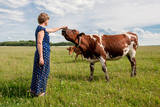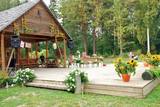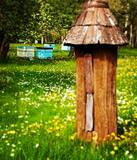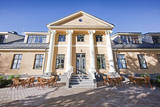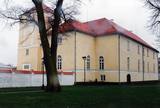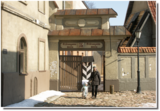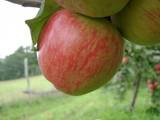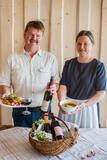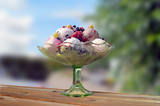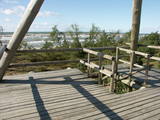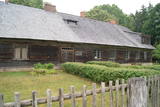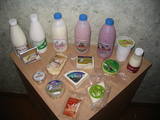Contact information
Related objects
| Photo | Name | Description |
|---|---|---|
|
A very impressive ensemble that is in terrible shape. The estate dates back to the 18th and 19th century, with the castle being built in the early 19th century. Half a century later it was rebuilt in the Neo-Gothic style with symmetrical towers and bricks in the cornices. The estate belonged to the Manteufel-Stzege dynasty. The vestibule, stairwell and second floor hall still have ornamental ceiling paintings, but visitors are not allowed to enter the building, so they cannot be seen. Valuable interior design elements include a fireplace from the early 19th century that is decorated with marble elements. After the expropriation of the castle in 1920 and until 1951, the building housed a forestry school and then an agricultural crafts school. Opposite the castle was the stable of the state that was built in the style of Classicism with a pediment and mighty columns. Built in the early 19th century, the stable is no longer used and can only be viewed from the outside. A very much overgrown park surrounds the complex, and the hillock is the grave of one of the baron’s dogs.
|
||
|
This biological farm (Bio 05-049-2008) grows berries such as strawberries and summer and autumn raspberries, as well as vegetables and grains. Visitors can pick and eat berries and look at the garden. The owners also breed cattle and have a store at which biological vegetables and fruits from the farm itself and from others can be bought. During the hay season during the summer visitors can spend the night in bales of hay.
|
||
|
The Jaunpils Dairy was opened more than 100 years ago, in 1912, and it produces semi-hard and soft cheeses, cottage cheese, cream, desserts and other dairy products. Only milk from Latvian farmers is used, and the products are exported to more than 17 countries in the world. Products are also sold at the store that is adjacent to the company. |
||
|
This is the first farm in Latvia which began to grow mushrooms. Informative tours are available, advice is given, and guests are treated with the “emperor mushroom” sauce or soup. You can also order other foods which involve shitake mushrooms or purchase them in dry or powdered form. The owner also produces an ancient herbal beverage called “Ponšo,” and it is only available at Garīkas. |
||
|
The tower is in the western part of the Vasenieki swamp, and an interesting nature trail with information stands and pathways was recently established there. The tower offers a look at unique swampland – visitors can survey the entire swamp. Wear proper footwear when it is damp outside!
|
||
|
Geidas *Object Inactive*
|
The farm specialises in dairy farming. Students and others can go on an educational tour, “The Route of Milk,” during which they will be able to churn butter and learn about how dairy products are produced. |
|
|
One of the largest castles in Kurzeme, this building has been preserved in fairly good shape. Work on its began in the mid-13th century, and it was commissioned by the heads of the Dome Cathedral in Rīga. In 1434, the estate was bought by the bishop of Kurzeme. The Maidel and Osten-Sacken dynasties owned it from the 16th to the 20th century. The Dundaga Castle burned down twice and has been rebuilt many times. The last reconstruction was in 1905, after the castle was burned down during the revolution. Of interest on both sides of the castle’s door are stone carvings of a knight and a bishop. In recent years, the hotel in the castle has been renovated, as has the second floor hallway and a terrace that is popular for weddings. There are many legends about the castle, including one about a wedding of elves and another about the Green Lady. Today the building houses the Dundaga School of Music and Art, a hotel, party rooms, the Dundaga Tourism Information Centre and various exhibitions. It is worth finding a guide to tour the castle. Groups of tourists can also order tastings of local foods. |
||
|
This farm offers tours, seminars and training for beekeepers. You can visit the bees, help to grow queen bees, produce honey and candles, and taste some of the good things that come from beehives. This educational facility will inform you about beekeeping traditions and allow you to work as a beekeeper. The owners share their knowledge during training sessions. |
||
|
The granary and cheese-making facility of the former Sieksāte (Berghof) Estate now house a museum (since 1985) which tracks the route of milk from the cow to the finished product. You can try your hand at milking cows and churning butter, and then you can taste what you have created. There is also a garden of fallow deer. |
||
|
The farm specialises in goat farming and goat cheese. Tours are available with tastings and purchase of products. The herd has some 150 goats, and visitors can taste and buy goat cheese. The farm is certified as a biological farm that focuses on environmental health. |
||
|
The Laumu Nature Park *Object Inactive*
|
The Laumas farm offers you a chance to be a beekeeper, watching the lives of bees in hives (while wearing a beekeeper’s suit), touring a bee trail and climbing a tree with the help of a truss. You can make wax candles and purchase beekeeping products such as honey, bee pollen, etc. A café is open during the summer, and there are areas of picnics. Latvian cuisine: Bean and dumpling soup, pancakes with jam, homemade lemonade, herbal teas. Special foods: Porridge a la Fairies. |
|
|
You can take an individual trip through the mini-zoo or have a guide to accompany you. You will see 16 types of doves, a Vietnamese pigmy pigs, river rats, rabbits, chinchillas, goats, parrots, turtle doves, ducks, geese, chickens, pheasants, and other birds. Children will love feeding the animals and establishing contacts with them. |
||
|
For more than 20 years the company has been partnering with some 100 local suppliers of milk. Its main principle is to offer healthy dairy products, including kefir, cottage cheese, cream, yogurts and soft cheese. SIA Elpa is the only dairy processing company in Southern Kurzeme that offers tours and tastings of products. Products can be bought, and during the tours, visitors can taste kefir, cheese and yogurt and help with the dairy processing process themselves. |
||
|
The pride of the farm is a herd of approximately 100 goats, and the owner produces milk, cheese, cottage cheese and yogurt from goat milk. You can go on a tour, visit the animals, and taste and purchase biologically produced and healthy products. You can go fishing in the nearby pond and then grill your catch. |
||
|
This is the largest herd of alpacas (an animal from the mountainous regions of South America) in the Baltic States. You can observe the animals, listen to stories about them, and buy alpaca wool. There are plans to transfer the herd to the Vīceži Estate in the Lībagi Parish in 2014.
|
||
|
The Talsi Dairy was established in 1922 after merging several other dairies. The Talsi Dairy company was established later on these foundations. One of the best known products is “Talsu Ritulis” cheese. Products such as milk, kefir, cottage cheese, butter, cheese, etc., can be purchased at the “Piena sēta” store that is alongside the company. |
||
|
“Airītes” is a museum found at the place where the first commander of the Latvian Armed Forces, Col Oskars Kalpaks and other Latvian soldiers (including three officers) fell during a battle on March 6, 1919. The public donated money in 1920 to build a monument, and it was unveiled on September 3, 1922. In 1935, work began on a building that was proposed by the Col Kalpaks Battalion organisation, the plan being to exhibit items related to Kalpaks’ battles. It was opened a year later. The monument was destroyed during the Soviet era, and the building housed a post office and some flats. The memorial was restored during the national Renaissance in 1988 and 1989, and on November 11, 1990, the museum was reopened. During renovations in 2007, the second floor burned down. The museum and exhibition were renewed in 2013. The exhibits speak to Kalpaks’ life during World War I and Latvia’s liberation battles. Employees regularly organise commemorative events in honour of Kalpaks, as well as celebrations of Lāčplēsis (Veterans’) Day. |
||
|
The trail informs visitors about one of the loveliest natural habitats in
|
||
|
This is the only Straw Museum in Latvia, with ~370 sculptures and dolls made of straw and hay. Children in particular will love the chance to learn skills related to straw and hay at the creative straw workshop, where specific methodologies have been developed. Children will be able to take the things that they create along with them. The owners prepare holiday designs and elements, as well as attractive souvenirs. |
||
|
This is a beautiful farm that is friendly to the environment and has some 300 hives of bees. There is a shop along with a tasting hall where you can enjoy honey made of various flowers, pollen (including pollen in honey), propolis (also in honey) bee bread, wax and souvenirs. Taste beekeeping products (including honey wine) and take a tour of the farm, as well. This farm uses traditional hives to extract honey, and it offers a look at hives that were used in the past. The owners are happy to talk about the development of beekeeping in Latvia and their experience in this regard. New! BeeHive bee healing therapy! |
||
|
Old household where the owners are beekeepers. Upon request, provides an educational programme and visits for schools and events. |
||
|
The farm breeds goats and uses goat milk to produce cheese and other products. A presentation hall offers visitors a chance to taste ice cream made of goat milk, as well as purchase goat-related souvenirs and other products. There are tours of the farm, too. |
||
|
The Upmalnieki ceramics workshop of Ugis Dainis *Object Inactive*
|
The ceramicist produces dishes, bowls, cups, other dishware, as well as decorative products. You can try your hand at the potter’s wheel, take part in the opening of the wood-fired kiln, watch demonstrations of the work, and order and purchase products based on the technique of fumigated ceramics. |
|
|
The ceramicist works in the household building of the Durbe Castle. You can watch her at work, try your hand at ceramics work, order artworks and purchase clay souvenirs. You can also tour the Durbe Castle complex, which is undergoing renovations at this time (2013). |
||
|
The rock is not too big (2.1 m high, 15 m in circumference), but since the early 20th century it has been a popular tourist destination. There is a lovely view of the
|
||
|
Skrunda Manor is located on the bank of the River Venta, on the side of the Riga-Liepāja highway. It is a hotel with 12 comfortable rooms, banquet halls, and conference rooms. The manor restaurant uses products grown in Latvia and produced by local farmers, offering its guests to taste original local dishes, such as carp croquettes with homemade rhubarb mayonnaise, pork belly with birch leaf syrup and celery, and a selection of ice cream made in the manor. |
||
|
The name of the location translates to “Honey Castle,” and the owner has some 300 hives of bees. Honey that he has produced has won a number of prizes. He offers hogweed honey, honeyed local berries, and honey straws for children (the only place in Latvia where these are offered). You can tour the farm, taste ten types of honey, and purchase beekeeping products. “Extreme Beekeeping” is a process which will allow you to put on a beekeeper’s suit to learn about the hard-working insects up close. The owner also produces wax candles. |
||
|
You can try your hand at pottery and take part in the opening of the kiln. You can also order and purchase ceramics. |
||
|
Abavas Winery, located near Tukums, invites you to taste Latvian fruit and berry wines, ciders, a variety of non-alcoholic drinks, as well as spirits. History Grapes Apples For Visitors Where to Buy |
||
|
This is the only viewing platform of its kind. It is north of Pāvilosta, between the sea and Latvia’s largest gray dune. The second level of the platform offers a good view of the habitats which surround the dune, as well as the seashore and the largest seashore rock on the shores of the Baltic Sea – the Pāvilosta sea rock. You can also see the northern part of Pāvilosta. When it is windy outside, you’ll see kiteboard riders showing their tricks.
|
||
|
Construction on the lighthouse was initially completed in 1879. The structure suffered damage during both world wars and was restored several times. The structure is 19 metres high and stands 46.5 metres above the wavy sea. Here you will find one of the loveliest views of the shores of the Baltic Sea.
|
||
|
The Castle of the Livonian Order in Ventspils was first listed in documents in the late 13th century, and despite damaging wars, it has maintained its essence as a castle to this very day and only with minimal changes. The castle is also known as the oldest Medieval fortress in Latvia. Today it is home to a modern museum. |
||
|
The biggest and the most impressive public decoration in the open air which was originally built in 2004 as the set for the film „The guards of Riga”and later as the set for the film directed by J.Streich „Rudolf’s inheritance”. Here you will also find the weapon museum Arsenal (contains weapons of different periods, uniforms and household goods), as well as the bakery "Laci". |
||
|
After viewing the lovely scenes that are a part of the Drubazi nature trail, which runs along the banks of the Ancient Abava River Valley, the owner offers tastings of homemade wine. He produces wines from 12 different berries, including raspberries, black currants, blackberries, lingonberries, grapes, sea buckthorn, and others. |
||
|
This farm is in a lovely location on the western side of the Talsi hillocks, offering a look at Talsi and its area. This is an open farm with grows and processes apples (dried apples, apple chips, apple juice). Visitors are offered an informative tour, with a chance to taste and purchase the products. The farm is in a protected natural area -- the Talsi Hillocks Nature Park. There is an area for tenting during the summer. The owners will teach you to produce a crown from fruit tree branches. The gardens of the farm stretch across the hillocks, and there are several types of local apple trees that are nurtured by the lady of the house. An informative stand alongside the farm features information about the most important values of the nature park. |
||
|
Found along
|
||
|
This winery produces wine from fruits and berries from its own garden, as well as from wild fruits and berries – raspberry, apple, gooseberry, blackberry, strawberry, red bilberry, rowanberry, blueberry, red currant, elderberry, shadberry and dandelion wine. The main product is sparkling wine from raspberries that is similar to
|
||
|
Druvas saldejuma razotne *Object Inactive*
|
Druvā saldējumu ražo no īsta piena, pievienojot dabīgus ievārījumus un ogas. Īpašais lepnums ir Cigoriņu saldējums. Apmeklētājiem tiek piedāvātas degustācijas ar stāstījumu par saldējuma vēsturi un tapšanas procesiem, kā arī individuāli piemērotas svētku programmas. Savukārt firmas veikaliņā “Saldējuma pagrabiņš” Saldū iespējams nobaudīt īpašus saldējuma desertus ” |
|
|
The Grey Dune of Pāvilosta nature reserve covers 42 hectares of land and has been designated to protect Latvia’s widest dune (1.5 km parallel the seacoast, and 812m in the direction from the sea to inland) and the biotopes and species found there. A two-storied watching platform is built to savour the scenery. In Soviet time, local fishermen used to dry seaweed in dunes for production of agar, and thus rich vegetation developed in the dune. The Gray Dune is part of a unique landscape with the sea view, the traditional architecture of Pāvilosta fishing town, and biotopes, including protected, which border the nature reserve: pine forest, embryonic dunes, white dunes, and wet beech where once can find springs. Biotope 2130, “Fixed dunes with herbaceous vegetation (grey dunes)” is found here. At present, pines are taking over the biotope, therefore some maintenance activities are required. The Grey Dune is most beautiful in the second half of July and in August when the blossoming Breckland Thyme (Thymus serpyllum) and Narrowleaf Hawkweed (Hieracium umbellatum) colour the dune in shades of yellow and violet. The most typical species here are Pasqueflower (Pulsatilla pretense), Grey Hair-grass(Corynephorus canescens), Blue Hair Grass (Koeleria glauca), Sand Pink (Dianthus arenarius). The Gray Dune earned wide recognition when a group of enthusiasts actively campaigned for six years to achieve the status of the nature reserve. Guna Grimsta, a group representative remembers that they organised events and activities throughout Latvia involving large part of the society, prominent personalities, church parishes, NGOs, school youth and university students. The activists were writing letters, making videos, doing research articles, composing music, collecting signatures and submitting proposals to achieve official status of the Grey Dune as an especially protected nature site. They organised seminars, concerts, art plenaires and exhibitions, educational excursions, joint-work, musical church services, meetings with high officials and their on-site visits to the Gray Dune. In 2006 the group received the title „Proudness of Latvia” awarded by the national TV3 broadcasting company and daily paper „Diena”. |
||
|
The Kubalu school was opened in 1843, and for 28 years it was the only school for the children of peasants at the Dundaga Estate. This is the oldest log schoolhouse in
|
||
|
In the Berzini homestead they bake exceptionally tasty wheat and rye bread in accordance with the old folk recipes. The taste and smell is the result of baking bread in a special oven which is more than 70 years old. It is possible to order bread, or, having booked a visit beforehand, to make and bake your own bread loaf. The owners will teach you bread baking traditions and use recipes from their ancestors to bake loaves in a true bread oven. |
||
|
At Jūrkalne, there is a small viewing area on the steep shore which offers a magnificent view. At the foot of the shore, which can be accessed via a set of steps, the view is no less wonderful. It is worth hiking along the entire shore from Pāvilosta to Sārnate (approximately 30 kilometres).
|
||
|
Dundaga cheese *Object Inactive*
|
The dairy co-operative Dundaga offers cottage cheese, sour cream, curdled milk beverages, small cheeses, and the Taizelis brand of cheese – all at the Dundaga Castle. The products are entirely without preservatives or ingredients meant to extend sales periods.
|
|
|
35 m wide and 0.5 m high, the
|







